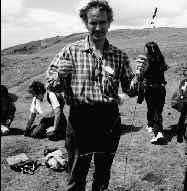
Effective collection, management and use of biological information is at the heart of the Trust's work - the information resource upon which our conservation activities are based places us in a unique position to advise. Stella Turk and Paul McCartney retrace the evolution of our Environmental Records Centre for Cornwall and the Isles of Scilly (ERCCIS) from the former Cornish Biological Records Unit (CBRU).
It is over a quarter of a century since the Cornish Biological Records Unit was instigated as one of the projects of the then new Institute of Cornish Studies. Frank Turk was asked to undertake this as part of his role as an Extramural Department tutor - so combining the University of Exeter in a double role (relating to the Institute as well as Adult Education) together with the County Council (as sponsor of the Institute). In 1980, on his retirement, Stella Turk was appointed Honorary Academic Director, and from 1993 to 21st December 1996 Adrian Spalding became Academic Director.
From 1972 to 1988, card indices of approximately half a million records were amassed from published sources by various willing "scribes" but mainly by the efforts of Brian and Elizabeth Jackson, in the later years aided by Pamela Tompsett and Mervyn Hallett. At the same time an index of sources was compiled and, Cornwall being a popular place for visiting naturalists over the centuries, this grew too and encompassed national as well as international journals. Compilation of sources was undertaken by government trainees in association with the Local Studies Library.
Over the years, a network of recorders and recording groups was established in Cornwall and beyond. Rose Murphy was particularly diligent in promoting the study of vascular plants whilst others gave much time to recording, especially marine life.
Frank Turk conceived the records unit as embracing all species - marine, land and freshwater - that had lived or still live west of the Tamar, so that it would be useful for a wide range of interests, including those of research and conservation. This has come to be recognised as a wise strategy in the light of the extinctions and threatened extinctions of species, and the conferring of Red Data and nationally scarce status on little-known invertebrates. The records were invaluable in compiling the Red Data Book for Cornwall and the Isles of Scilly (1997), edited by Adrian Spalding, and continue to be useful for work on Biodiversity Action Plans and long-term monitoring of global warming, whether the long-term outlook is waxing warmer or waning colder for the British Isles.
In May 1989 computerisation was officially started, under the control of Colin French who devised a programme called ERICA (Environmental Records in Cornwall - and the Isles of Scilly by implication and in fact - Automated), designed not to exclude any of the data on the card index. With various government manpower training schemes, a steady input of 3,000 records a week was maintained, allowing the unit to keep up with incoming records. The millionth record was celebrated in March 1996, the number of species then being almost 22,000.
In summer 1996 there were changes in the funding. Money was withdrawn from the CBRU, some staff were made redundant and on 1st January 1997 the records unit was transferred to the Cornwall Wildlife Trust where NEW ERICA was made available in its rewritten form to run on a PC.
The Cornwall Wildlife Trust, formed in 1962, had always focused attention on wildlife sites and habitats, with species lists as appropriate. With a combination of ground surveys and habitat mapping using aerial photography, the Trust held information relating to all of the county's land cover together with surveys of about 750 sites ranging in size from less than an acre to the whole of Bodmin Moor. This set of information provides an extension to, and complements, the species recording of the CBRU. The merging of these two systems in the early part of 1997 brought together two of the major sets of wildlife information relating to Cornwall. Our new centre has been named the Environmental Records Centre for Cornwall and the Isles of Scilly (ERCCIS).
This should be the beginning of wider co-operation, as Local Records Centres (LRCs) across the country adopt common standards and systems so that they may work towards exchanging the information that each of them holds. A major initiative, the National Biodiversity Network, is an ambitious proposal which has been designed to facilitate the flow of wildlife information between both the LRCs and national schemes and societies. ERCCIS is involved in the early stages of this work, which will hopefully be developed more fully early in the new millennium.
Stella Turk and Paul McCartney